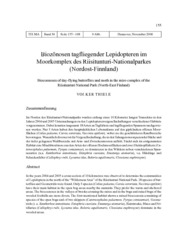Biozönosen tagfliegender Lepidopteren im Moorkomplex des Riisitunturi-Nationalparkes (Nordost-Finnland)
Thiele, Volker
36: 155 - 168
Thiele, Volker, 2006: Biozönosen tagfliegender Lepidopteren im Moorkomplex des Riisitunturi-Nationalparkes (Nordost-Finnland). In: TELMA - Berichte der Deutschen Gesellschaft für Moor- und Torfkunde, Band 36: 155 - 168, DOI: 10.23689/fidgeo-3046.
 |
Dokument öffnen: |
Abstract:
In the years 2004 and 2005 a cross section of 10 kilometres was observed to determine the communities of Lepidoptera in the north of the “Wilderness Area” of the Riisitunturi National Park. 18 species of butterflies and Geometrids were found. Only 3 species (Colias palaeno, Carsia sororiata, Vaccinia optilete) have their main habitat in the open bog areas nearby the summits. They prefer the warm and sheltered areas. The biocoenoses in the valleys of brooks crossing the mires and in the bogs and raised bogs of the wooded foothills are more divers. The first-mentioned habitat shows a mixed biocoenosis consisting of species of the open bogs and of two skippers (Caterocephalus palaemon, Pyrgus centaureae). Geometrids (i. a. Xanthorhoe annotinata, Entephria caesiata, Ematurga atomaria), Hairstreaks, Blues and Fritillaries (Callophrys rubi, Lycaena idas, Boloria aquilionaris, Clossiana euphrosyne) dominate in the wooded areas. Zusammenfassung:
Im Norden des Riisitunturi-Nationalparks wurden entlang eines 10 Kilometer langen Transektes in den Jahren 2004 und 2005 Untersuchungen zu den Lepidopterenvergesellschaftungen verschiedener Habitate vorgenommen. Dabei konnten insgesamt 18 Arten an Tagfaltern und tagfliegenden Spannern nachgewiesen werden. Nur 3 Arten haben ihre hauptsächlichen Lebensräume auf den gipfelnahen offenen Moorflächen (Colias palaeno, Carsia sororiata, Vaccinia optilete), wobei sie die geschützteren Randbereiche bevorzugen. Wesentlich diverser ist die Vergesellschaftung, die in den Talungen moorquerender Bäche und der tiefer gelegenen Waldbereiche mit Arm- und Zwischenmooren auftritt. Findet sich im erstgenannten Habitat eine Mischbiozönose aus den Arten der offenen Hochmoorflächen und zwei Dickkopffaltern (Caterocephalus palaemon, Pyrgus centaureae), so dominieren in den Wäldern neben verschiedenen Spannerarten (u.a. Xanthorhoe annotinata, Entephria caesiata, Ematurga atomaria), v.a. Bläulinge und Scheckenfalter (Callophrys rubi, Lycaena idas, Boloria aquilionaris, Clossiana euphrosyne).

